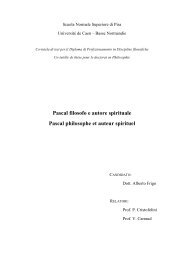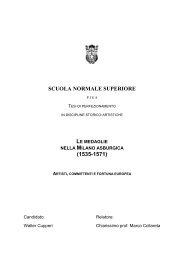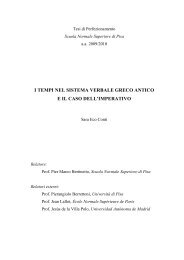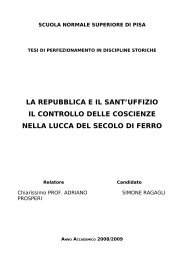- Page 1 and 2:
CATULLUS 68 Edited with an Introduc
- Page 3 and 4:
Bei irgendeinem Spätling muß doch
- Page 5 and 6:
the first place. As a result of all
- Page 7 and 8:
When I started working on this volu
- Page 9 and 10:
CONTENTS PREFACE ..................
- Page 11 and 12:
At first sight, this debate could a
- Page 13 and 14:
so that one would not have to look
- Page 15 and 16:
least, non utriusque in line 39 cou
- Page 17 and 18:
artistic unity of the poem ...” 2
- Page 19 and 20:
can only claim that an expression s
- Page 21 and 22:
later than the 6 th century A.D., a
- Page 23 and 24:
(c) Carmen 68 is unitary and concer
- Page 25 and 26:
Morgan is a separatist, while Lachm
- Page 27 and 28:
This solution was proposed by Frank
- Page 29 and 30:
(S 3) Lines 20 and 22-24 are repeat
- Page 31 and 32:
(S 5) In lines 1-40 Catullus says h
- Page 33 and 34:
in that of 1973 or in his 1988 revi
- Page 35 and 36:
address in poem 68 for a number of
- Page 37 and 38:
(1) R 2 (Coluccio Salutati) has add
- Page 39 and 40:
whether the evidence at our disposa
- Page 41 and 42:
later Torquatus tried unsuccessfull
- Page 43 and 44:
68a that may support such an identi
- Page 45 and 46:
straightforward Yes or No. In short
- Page 47 and 48:
from a private letter. This could b
- Page 49 and 50:
desertum in line 6). The second pai
- Page 51 and 52:
I propose a twofold solution. There
- Page 53 and 54:
***** Does Catullus reject both Man
- Page 55 and 56:
some sort of practical contribution
- Page 57 and 58:
methods and ideals of the doctus po
- Page 59 and 60:
If a wealthy Roman male 122 was des
- Page 61 and 62:
friends appear to have found romant
- Page 63 and 64:
CATULLUS 68B ‘Goddesses, I cannot
- Page 65 and 66:
There is space for disagreement abo
- Page 67 and 68:
to be rather flexible; evidently Ca
- Page 69 and 70:
loc.) - but here too it is not clea
- Page 71 and 72:
and Lesbia. Twenty-five years have
- Page 73 and 74:
One is the theme of human and divin
- Page 75 and 76:
his exemplar from those that he mad
- Page 77 and 78:
have been using not the archetype,
- Page 79 and 80:
The apparatus criticus I should cla
- Page 81 and 82:
It has been hard to decide whether
- Page 83 and 84:
38 Hamburg - Stadt- und Universitä
- Page 85 and 86:
CATULLI CARMEN LXVIIIA Quod mihi fo
- Page 87 and 88:
nam mihi quam dederit duplex Amathu
- Page 89 and 90:
ne Paris abducta gauisus libera moe
- Page 91 and 92:
huc addant diui quam plurima, quae
- Page 93 and 94:
poem through several stages of tran
- Page 95 and 96:
mihi mitto ‘to send’, ‘to hav
- Page 97 and 98:
daughter Tullia (Erskine 1997). Cic
- Page 99 and 100:
Να⌠ακο⎜ω ≥δη, δεσ
- Page 101 and 102:
spumantibus exspuit undis This expr
- Page 103 and 104:
A somewhat peculiar interpretation
- Page 105 and 106:
Prop. 1.8.33 and Tib. 1.1.43; terra
- Page 107 and 108:
In the present passage caelibe evid
- Page 109 and 110:
contemporaries; and it made Catullu
- Page 111 and 112:
10 ‘… and that (it is) from her
- Page 113 and 114:
• Theognis 249f. ο⎡ξ 〈ππ
- Page 115 and 116:
• Solon frg. 26 West ƒργα δ
- Page 117 and 118:
position to give them; he implies t
- Page 119 and 120:
Ellis (ad loc.), Schöll (1880: 473
- Page 121 and 122:
15-26 ‘I had my share of amorous
- Page 123 and 124:
man (and a Roman citizen), that is,
- Page 125 and 126:
actions (compare the plural of demo
- Page 127 and 128:
would not have been taken over into
- Page 129 and 130:
comedy (Pl. Curc. 697, Men. 1133, A
- Page 131 and 132:
their own (see on sepulta in the pr
- Page 133 and 134:
not] employ the offensively hyperbo
- Page 135 and 136:
closer to turpe. This would be an e
- Page 137 and 138:
quid agis? ...’). In general, scr
- Page 139 and 140:
frigida ... membra Since erotic fer
- Page 141 and 142:
29. What is ‘sad rather than sham
- Page 143 and 144:
introduces a new point that is in s
- Page 145 and 146:
1955 on Verg. Aen. 4.2, and cfr. Ca
- Page 147 and 148:
you both, if I had any to hand.’
- Page 149 and 150:
unius tantum ‘only of one’? Ove
- Page 151 and 152:
without any hint that the investmen
- Page 153 and 154:
68B: IN PRAISE OF ALLIUS 41-50 ‘G
- Page 155 and 156:
are solved by Scaliger’s brillian
- Page 157 and 158:
me’ is a much more suitable expre
- Page 159 and 160:
monument (Fordyce), which is the pl
- Page 161 and 162:
What makes the image effective and
- Page 163 and 164:
eference to Allius’ funeral is po
- Page 165 and 166:
Alternatively, it could be assumed
- Page 167 and 168:
the island of the cattle of the Sun
- Page 169 and 170:
fletu This verbal noun is well-esta
- Page 171 and 172:
Culex 123f. primum prona surgebant
- Page 173 and 174:
valley as if it were a slope than t
- Page 175 and 176:
It remains to consider the rest of
- Page 177 and 178:
prefers to follow O and writes uiat
- Page 179 and 180:
pronoun (‘this man’), as this w
- Page 181 and 182:
clausum Fordyce is probably right t
- Page 183 and 184:
characterize the gift and not the g
- Page 185 and 186:
far from the transmitted text, and
- Page 187 and 188:
the Elder, N.H. 17.134 cum sit mutu
- Page 189 and 190:
eloved as a goddess: thus Pl. Bacch
- Page 191 and 192:
significantly different from the pr
- Page 193 and 194:
511.65. constituo is not used elsew
- Page 195 and 196:
exist in Latin, to -au-, which did;
- Page 197 and 198:
77f. Catullus interrupts his narrat
- Page 199 and 200:
ieiuna … desideret ara The altar
- Page 201 and 202:
85f. The Parcae knew that Laodamia
- Page 203 and 204:
y this time. Argiuus, meaning not o
- Page 205 and 206:
Meillet s.v. cinis), but the Italia
- Page 207 and 208:
that might simply be because it is
- Page 209 and 210:
cognatos … cineres Enallage: ‘r
- Page 211 and 212:
should be attached to the orthograp
- Page 213 and 214: were using the aspirated forms (Ora
- Page 215 and 216: 109 quale Here and at 111 quod the
- Page 217 and 218: Stymphalia monstra ‘The Stymphali
- Page 219 and 220: altior illo, / qui … , which woul
- Page 221 and 222: First, it is hard to see how the ne
- Page 223 and 224: et flumina uim minuerunt and 6.645
- Page 225 and 226: 126 improbius ‘More shamelessly
- Page 227 and 228: 1549 - see Nomenclator 96), whose a
- Page 229 and 230: garments, and the colours croceus a
- Page 231 and 232: prose it is replaced by tametsi. It
- Page 233 and 234: eassuring environment, with the win
- Page 235 and 236: (Theb. 7x, Ach. 1x, Silu. 1x), Juve
- Page 237 and 238: omniuoli This hapax legomenon is su
- Page 239 and 240: this line at himself. But why shoul
- Page 241 and 242: (Fordyce), nor is there any need to
- Page 243 and 244: Consequently I do not think that on
- Page 245 and 246: (1958: 103) and Trappes-Lomax (2007
- Page 247 and 248: Trappes-Lomax (2007: 244) notes tha
- Page 249 and 250: to diuus (7x against 2x), in the lo
- Page 251 and 252: All these supplements presuppose th
- Page 253 and 254: directed to God the Creator. He cou
- Page 255 and 256: transdidi used by Fronto (Epist. p.
- Page 257 and 258: for a shipwrecked man but must be a
- Page 259 and 260: the previous and the following dist
- Page 261 and 262: would have never wanted to say that
- Page 263: conjecture and proposed another rec
- Page 267 and 268: APPENDIX II: CATULLUS’ SOURCES FO
- Page 269 and 270: Catullus calls Protesilaus’ house
- Page 271 and 272: BIBLIOGRAPHY A note on references C
- Page 273 and 274: PLM Aemilius Baehrens ed. (1879-188
- Page 275 and 276: G Catulle, Manuscrit de St-Germain-
- Page 277 and 278: Hartman, J.J. (1916), ‘De Catulli
- Page 279 and 280: Heine, Rolf (1975), ‘Zu Catull c.
- Page 281 and 282: Newman, John Kevin (1990), Roman Ca
- Page 283 and 284: Berry, D.H. (1996), Cicero: Pro P.
- Page 285 and 286: Graziosi Acquaro, Maria Teresa (197
- Page 287 and 288: Pomey, Patrice (1997), ‘Les dange
- Page 289: --- (1929), ‘Sepulcri Portuensis






